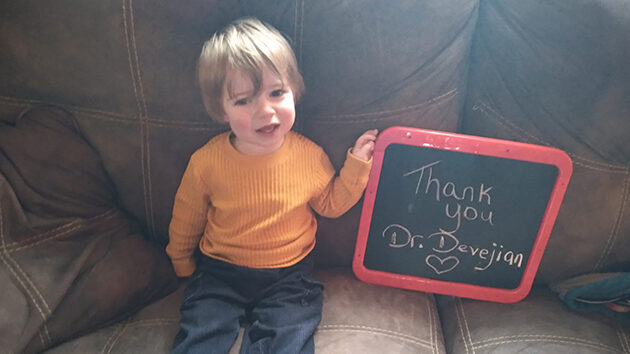Congenital Heart Program for our Youngest Cardiac Patients

Shortly after Sierra Rathburn learned her baby would be born with a congenital heart defect, she felt hopeful knowing the team at the Bernard & Millie Duker Children’s Hospital could help save his life.
During an anatomy scan, an ultrasound performed around 20-weeks of pregnancy, Sierra noted, “The ultrasound tech was scanning over the heart a lot. She got very quiet, and I knew something wasn’t right. I waited to speak to the doctor, and they told me the baby had Hypoplastic Left Heart Syndrome.”
Hypoplastic Left Heart Syndrome (HLHS) is a congenital heart defect in which the left ventricle, the major pumping chamber sending blood from the heart to the body, does not fully develop. This leaves the right ventricle, designed only to gently pump blood to the lungs, to pump blood to both the lungs and the body at the same time.
Sierra lives in Knox, 25 miles west of Albany. Her doctors recommended she switch her care to Albany Medical Center, so when she gave birth, her baby could get immediate care at the Bernard & Millie Duker Children’s Hospital. The Congenital Heart Program is the region’s only comprehensive pediatric cardiology care center for patients of all ages with congenital cardiac diseases and is a top performer in New York State.
“When I heard the news, my first thought was ‘why is this happening?’” Sierra said. “But my second thought was, ‘There’s a chance he’ll be OK.’ I was very relieved and grateful to have this resource so close.”
Riley Rathburn was born in May 2022. “I held him for a minute, and I looked at him the entire time, because I knew our time together at that moment would be limited,” Sierra said.
Riley was rushed away to the NICU and given medication to keep his blood flowing to the body until he could have heart surgery two days later.
“HLHS is widely regarded as one of the most high-risk anatomies and syndromes in medicine. It requires three surgeries to reduce the work of the heart,” said Jess Randall, MD, who specializes in congenital interventional cardiology.
Pediatric Cardiothoracic Surgeon Neil Devejian, MD, has performed more than 2,000 operations to correct congenital heart defects and has more than two decades of experience treating the most complex cases. This includes all three of the highly specialized surgeries necessary to appropriately redirect flow and help the heart work most efficiently.
Riley’s first surgery was the Norwood procedure.
“Riley’s HLHS was very unique,” Dr. Randall said. “He had a large coronary artery fistula that put his heart muscle significantly at risk following surgery. After multiple discussions about the best means for management, Riley underwent Norwood procedure and required intense post-operative management. Overall, he was able to recover and do well.”
After two months of intensive care under the guidance of the congenital heart team, he was able to be discharged home.
Following Riley’s second surgery, he was one of the first patients to be followed by the Congenital Heart Program’s formalized interstage program. Each day, parents submit the child’s weight, heart rate, and oxygen saturation, which are closely followed by Kimberley Branigan, NP and Olga Martin, PA. If they note something concerning, they bring the patient in immediately. He visited the Capital District Pediatric Cardiology Associates clinic every two weeks for an echocardiogram and close monitoring until his second surgery.
“Thanks to donated funds for infant scales and cardiac care bags for families, we can send our patients home with more resources and a formalized program to follow them more closely,” Dr. Randall said.
“Children with HLHS can be very fragile, they may have issues after their surgeries, and they are less able to deal with an illness,” said Adnan Bakar, MD, pediatric cardiac intensivist. “We make sure to follow these children very closely when they are home to ensure that everything is going well or if they may need intervention.”
Today, Rathburn says nearly 2-year-old Riley is doing well and has a lot of energy. “It’s amazing to see how far he’s come, and I’m just so happy where he’s at now.” “I want people to know that just because their heart is built differently, that doesn’t make them any less of a kid. We shouldn’t put limitations on them because every time they’re going to blow you away!” she said.